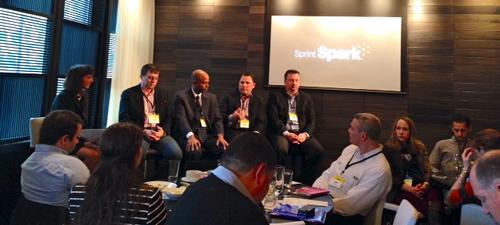Sprint Eyes SDN to Re-Craft Its Core CHICAGO --
Post# of 17655

Sprint Eyes SDN to Re-Craft Its Core
CHICAGO -- SDN and NFV are the flavors of the month right now, according to Sprint's chief technology officer, but the network man sees both technologies as a way to re-create its core -- someday, at least.
Stephen Bye, CTO and SVP of Sprint Corp. (NYSE: S), told Light Reading this during the Q&A session of a panel the operator held in Chicago on Tuesday. While acknowledging that both software-defined networking (SDN) and network functions virtualization (NFV) are hyped right now, he said they are a serious development for the wireless industry.
"For us, it represents an opportunity to re-architect how we do the core network and how we think about it," Bye said. "It's really bringing some of the more evolved software practices into a telco infrastructure that over time hasn’t kept up with how technology is going from a software perspective. It's not a question of if , it's a questions of timing and how we evolve to that."
That timing may come down to when the technologies are more standardized. Bye said Sprint is working with its new parent, SoftBank Corp. , as well as operators across the globe on standardization to help drive down costs. He said there's a lot of work going on around SDN, giving a nod to Sprint partner and fellow panelist Nokia Solutions and Networks VP Bill Payne, who added that NSN is on the front-end of both SDN and NFV.
Bye and Payne were joined on the panel by Brian Berner, regional VP of Spotify , and Yankee Group Research Inc. analyst Rich Karpinski. The discussion covered a range of topics from network evolution to mobile entertainment to attracting more budding engineers. (See Sprint Accelerator: Changing Carrier DNA .)
Click on the image below for a few snaps from the event in downtown Chicago.

One thing Sprint is (still) working on today is evolving its wireless network through Network Vision and filling in the gaps in its LTE network. Sprint has said in the past that it will fire up an LTE market when it at least has "street-level coverage," but Bye said his priority today is covering entire markets with Spark, which spans three frequency bands -- 800 Mhz for indoor coverage, 1,900 MHz, and 2.5 Ghz, its "workhorse in terms of capacity and speed." (See When is a 4G LTE Market Really Covered, Anyway? , Sprint Sparks It in Chicago , and Sprint Sparks Up Vendors for Faster 4G LTE .)
"Coverage is not about isolated pockets, but creating a ubiquitous experience," Bye said. "We are working on three cell sites a day, adding capacity and speed to that infrastructure."
That includes deploying small cells where needed, both indoors and out. NSN's Payne added that small cells address high-density local traffic, and the key for the vendor in deploying them is to build equipment that can accommodate quick capacity upgrades when needed. (See Sprint Plans Indoor, Outdoor Small Cells in 2014 .)
Interestingly, Bye said it wasn't the cost of equipment that is the biggest hindrance to Sprint's ambitious network build; it's the cost of working with a city like Chicago. (See WiFi: Small Cells' Trojan Horse? and Small Cells in the City .)
"When we look at the infrastructure investment we make, we deploy hundreds of cell sites. Equipment is a small part of the cost. It's construction, zoning, permitting that creates the long time frame to build and takes up the most investment. No one wants a big cell tower. It's not really about the equipment. It's all the infrastructure and labor around it. We are spending billions per year building out infrastructure."
 (0)
(0) (0)
(0)